Abstract
The application of antique medical instructions, practices, skills and knowledge has been considered as the most affordable treatment in many developing countries. The use of these preparations and prescriptions over generations has made a useful and valuable guide for drug discovery in modern medicine. Medical herbs have been of a high importance for this purpose. The genus Dorema, of Apiaceae family (Umbelliferae) has a wide use in ethnobotany and traditional medicine around the world. It has been used as a treatment for CNS disease, convulsion, upper respiratory tract problems, gastrointestinal disorder and high blood sugar. Furthermore, phytochemical investigations have reported Dorema species to contain a wide range of constituents including terpenes, coumarins and phenolic compounds. The current review summarizes comprehensive information regarding botany, phytochemistry andpharmacological aspects of Dorema spp.
Keywords: Dorema, phytochemistry, pharmacology
INTRODUCTION
The genus Dorema D. Don, belongs to the Apiaceae family (Umbelliferae) with important medicinal and aromatic species. It contains a total of 12 accepted species worldwide (http://www.theplantlist.org). Among them 7 are represented in Iran [1]. The genus has been used as a food additive as well as for various medicinal purposes in traditional and folklore medicine around the world [2].
Dorema ammoniacum, commonly known as “Ushaq” or “Vasha”, is considered as one of the most studied species [3]. Being rich in ammoniacum, a medicinal gum-resin, it has been mentioned in Islamic Traditional Medicine (ITM) as a treatment for various disorders, such as gastrointestinal, upper respiratory tract and central nervous systems problems [3-5]. Furthermore, numerous chemical compounds including terpenes, coumarins and phenolic compounds have been isolated from Dorema species and a wide range of pharmacological activities including anti-microbial, anti-inflammatory, antioxidant, cytotoxicity, anticonvulsant, anti-diabetic and hypolipidemic activities have been reported from this genus in modern medicine [6].
In the current review we present a comprehensive report on ethnobotanical and traditional uses, phytochemical compounds and pharmacological activities of the genus Dorema.
BOTANY
1. Botanical description of Dorema spp.
Dorema species are large monocarpic perennial plant, with thickened storage roots, and have large simple umbels with regular flowers, bisexual and staminate, the bisexual on upper branches and the staminate on lower, rarely flowers mixed; Involucre of few caducous leaflets, or lacking; calyx 5-toothed, indistinct; petals are yellow, cream- colored or greenish yellow, nerve darker, ovate- elongate, with inward curved tip; The stigmas are truncate or thickened; stylopodium is flat, fleshy with lobed broadened margin, becoming cup-shaped; ovary is cylindrical, faintly ribbed. Fruit with free carpophore, dorsally piano- compressed, elliptic, with filiform protruding ribs, 2 lateral ribs fusing with unthicken, whitish margin. Geographically, Dorema is distributed in the Caucasus and the southern parts of Central Asia. It also grows in Iran, Afghanistan and Baluchistan. Its northernmost representative (Dorema microcarpum Korovin.) appears in Central Asia, its southern limit lies in Tien Shan. Dorema is typical in arid conditions and most species occur in dry foothills and hills, some grow in deserts.
They are confined to calcareous soils, often mixed with rock debris. One species, Dorema sabulosum Litv. is a typical psammophyte [7, 8]. According to The Plant List, there are 25 scientific plant names of species rank for the genus Dorema, of these 12 are accepted species names (http://www.theplantlist.org). In Iran, the genus Dorema is represented by seven species, namely, D. aitchisonii Korovin ex Pimenov, D. ammoniacum D.Don, D. aucheri Boiss., D. aureum Stocks, D. glabrum Fisch. & C.A. Mey., D. hyrcanum Koso-Pol. and D. kopetdaghense Pimenov which among them D. aucheri Boiss. is endemic to Iran. Dorema kopetdaghensePimenovin Flora Iranica, treated as a synonym of D. hyrcanum Koso-Pol. However, phylogenetic analysis of nrDNA internal transcribed spacer (ITS) sequences showed that these two species should be retained as separate species [1, 9, 10]. Table 1 summarizes all synonyms of Dorema species based on the website “TPL” (http://www.theplantlist.org).
Table 1.
Scientific names and synonyms of reported Dorema species worldwide [according to The Plant List (2013)]
| No | Dorema species (Accepted names) | Synonyms |
|---|---|---|
| 1 | D. aitchisonii Korovin ex Pimenov | |
| 2 | D. ammoniacum D.Don |
D. gummiferum (Jaub. & Spach)
K.M.Korol. D. hirsutum Lofius ex I.G.Borshch. |
| 3 | D. aucheri Boiss. | D. robustum Lofius ex I.G.Borshch. |
| 4 | D. aureum Stocks | |
| 5 | D. badhysi Pimenov | |
| 6 | D. balchanorum Pimenov | |
| 7 | D. glabrum Fisch. & C.A.Mey. | |
| 8 | D. hyrcanumKoso-Pol. | D. gummiferum auct. |
| 9 | D. karatavienseKorovin | |
| 10 | D. kopetdaghense Pimenov | |
| 11 | D. microcarpum Korovin | D. namanganicum K.M. Korol. |
| 12 | D. sabulosum Litv. | D. sabulosum var. borszczowii Litv. |
2. Threats and conservation priorities
The genus Dorema, contains monocarpic perennial species, so that only once produces flowers during the life cycle and only reproduces through seeds. These plants are potentially endangered and vulnerable taxa [11]. Some of these taxa such as D. aucheri are narrow-range endemics which occur only in a few specialized niches. D. aucheri is considered as a unique endemic species which is intensively collected. Overexploitation of this plant has caused a significant decrease in its population in the area [12]. Furthermore, some others are sub-endemics with threatened species including D. ammoniacum, and D. kopetdaghense. Today, D. kopetdaghense is also considered as endangered in the IUCN Red List of threatened Species [13]. It has been used in traditional medicine from ancient times [2].
Dorema ammoniacum commonly known as “Ushaq” or “Vasha” is one of the most important industrial and medicinal plants of Iran which has been used in ethnobotanical since ancient times. It is endangered due to superfluous and unsustainable harvesting methods [3, 4]. Dorema glabrum is another endangered species that grows in loamy or rocky slopes of Nakhichevan, Autonomous Republic- Azerbaijan, Armenia and Iran [1, 10]. The plant has immense applications as an herbal remedy or food additive in these regions. Over harvesting from wild populations and destructive collecting methods, are considered as serious threats that often lead to disappearance of these taxa, and must be avoided. There is an urgent need for conservation priorities and management strategies for all taxa assigned to a threat category through seed and gene banking, and planting in botanical gardens. Otherwise, we will lose these natural treasures within the next few decades.
PHYTOCHEMICAL CONSTITUENTS
The instrumental analysis was revealed that a range of various compounds were identified in Dorema species, including essential oil structure that made up hydrocarbon molecules and classified as terpenes, alcohols, esters, aldehydes, ketones and phenols, also contain phenolic and coumarin compounds (Table 2). These phytochemicals derived from different parts of Dorema species such as flower, fruit, leaf, stem and root.
Table 2.
Chemical composition from different parts of Dorema species
| Name of compound | Structure | Species | Plant part | Ref | |
|---|---|---|---|---|---|
| Essential oil components | |||||
| 1 | α-pinene |  |
D.
ammoniacum D. aucheri D. glabrum |
Aerial
parts Flower Stem Seed Leaf Root Leaves Aerial parts Stem Seed Aerial parts |
[14-18] [19, 20] [21] |
| 2 | camphene |  |
D. ammoniacum D. aucheri |
Flower Stem Root Seed Stem |
[14] [19, 20] |
| 3 | β-pinene |  |
D.
ammoniacum D. aucheri |
Flower Stem Root Seed Stem |
[14] [19, 20] |
| 4 | β-myrcene |  |
D. aucheri D. glabrum D. ammoniacum |
Seed Stem Aerial part Flower Stem Root Leaves |
[19, 20] [21] [14, 17, 18] |
| 5 | p-cymene |  |
D. ammoniacum | Aerial parts Flower stem Root |
[14, 15, 18] |
| 6 | limonene |  |
D. ammoniacum D. aucheri D. glabrum |
Flower
stem Seed Root Leaf Leaves Aerial parts Seed Stem Aerial parts |
[14, 16, 18] [19, 20] [21] |
| 7 | β-phellandrene |  |
D. ammoniacum | Aerial parts Root |
[15] |
| 8 | 1,3,8-p-menthatriene |  |
D. ammoniacum | Aerial part | [22] |
| 9 | p-mentha-1,8-diene |  |
D. ammoniacum | Fruit | [22] |
| 10 | (E)-β-ocimene |  |
D. ammoniacum D. aucheri D. glabrum |
Flower Stem Root Leaves Aerial parts Aerial parts |
[14, 18] [19] [21] |
| 11 | (Z)-β-ocimene |  |
D.
glabrum D. ammoniacum |
Aerial
parts Stem Leaves |
[21] [18] |
| 12 | terpinolene (δ-terpinene) |  |
D. ammoniacum D. aucheri |
Aerial
parts Flower Root Stem Leaf Leaves Aerial parts Seed Stem |
[14, 15, 17-19] [19, 20] |
| 13 | terpinene-4-ol |  |
D. aucheri | Aerial part | [20] |
| 14 | thymol methyl ether |  |
D. ammoniacum D. aucheri |
Flower
stem Root Seed Aerial parts |
[14, 16] [19] |
| 15 | thymol |  |
D.
ammoniacum D. aucheri |
Seed Stem Aerial part Seed Stem |
[16] [20] |
| 16 | methyl geranate |  |
D. aucheri | Aerial part | [19] |
| 17 | carvacrol methyl ether |  |
D.
ammoniacum D. glabrum |
Flower Stem Root Root |
[14] [23] |
| 18 | carvacrol |  |
D. aucheri D. ammoniacum |
Stem Seed Stem Seed |
[20] [16] |
| 19 | methyleugenol |  |
D. ammoniacum | Seed | [16] |
| 20 | bornyl acetate |  |
D.
ammoniacum D. aucheri |
Flower Stem Root Leaves Aerial parts Seed Stem |
[14, 18] [19, 20] |
| 21 | fenchyl acetate |  |
D. glabrum | Aerial parts | [21] |
| 22 | endo-fenchol |  |
D. ammoniacum | Leaf | [18] |
| 23 | α-fenchyl Acetate |  |
D. glabrum | Root | [23] |
| 24 | α-cubebene |  |
D.
ammoniacum D. aucheri |
Flower Fruit Stem Root Aerial parts |
[14, 22] [19] |
| 25 | β-cubebene |  |
D. aucheri | Aerial parts | [20] |
| 26 | β-elemene | 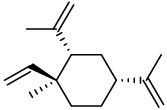 |
D. aucheri | Aerial parts | [20] |
| 27 | α-copaene |  |
D. ammoniacum D. aucheri D. glabrum |
Flower Fruit Stem Seed Leaves Root Aerial parts Seed Stem Root |
[14, 16, 22] [19, 20] [23] |
| 28 | β-copaene |  |
D. aucheri | Aerial parts | [22] |
| 29 | aristolene |  |
D. ammoniacum | Flower stem | [14] |
| 30 | β-patchoulene |  |
D. aucheri | Aerial parts | [19] |
| 31 | α-gurjunene |  |
D. ammoniacum | Flower stem | [14, 16] |
| 32 | β-gurjunene |  |
D.
ammoniacum D. aucheri |
Flower Stem Root Aerial parts Seed Stem |
[14] [19, 20] |
| 33 | β-caryophyllene |  |
D. ammoniacum D. aucheri |
Flower
stem Seed Root Leaf Aerial parts Seed Stem |
[14, 16, 17] [19, 20, 24] |
| 34 | caryophyllene | 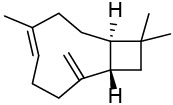 |
D. ammoniacum | Aerial parts | [15] |
| 35 | α-santalene |  |
D. aucheri | Aerial parts | [19] |
| 36 | aromadendrene |  |
D.
ammoniacum D. aucheri |
Flower
stem Seed Root Aerial parts |
[14, 16] [19] |
| 37 | α-guaiene |  |
D. ammoniacum | Flower
stem Root |
[14] |
| 38 | benzyl butanoate |  |
D. ammoniacum | Root | [14] |
| 39 | α-himachalene |  |
D. ammoniacum | Flower
stem Root |
[14] |
| 40 | allo-aromadendrene |  |
D. ammoniacum | Flower stem Root |
[14] |
| 41 | dehydroaromadendrane |  |
D. ammoniacum | Flower
stem Root |
[14, 16] |
| 42 | α-amorphene |  |
D.
ammoniacum D. aucheri |
Flower
stem Root Seed Stem |
[14] [20] |
| 43 | δ-amorphene |  |
D. ammoniacum | Flower
stem Root |
[14] |
| 44 | β-selinene |  |
D.
ammoniacum D. aucheri |
Flower
stem Seed Root Seed Stem |
[14, 16] [20] |
| 45 | α-selinene |  |
D. ammoniacum D. aucheri |
Aerial
part Flower Root Stem Seed Stem |
[14, 15] [20] |
| 46 | viridiflorene |  |
D. aucheri | Aerial part | [19] |
| 47 | α-muurolene |  |
D. ammoniacum D. glabrum |
Flower, stem Root Root |
[14] [23] |
| 48 | γ-muurolene |  |
D. ammoniacum | Stem | [16] |
| 49 | cadalene |  |
D. glabrum | Root | [23] |
| 50 | δ-cadinene |  |
D.
ammoniacum D. aucheri D. glabrum |
Flower seed Stem Aerial parts Seed Stem Root |
[14, 16, 17] [18, 20, 24] [23] |
| 51 | γ-cadinene |  |
D. aucheri D. ammoniacum |
Aerial
parts Seed Stem |
[19] [16] |
| 52 | cadina-1,4-diene |  |
D. aucheri | Aerial part | [19] |
| 53 | trans-cadina-1(2),4-diene |  |
D. ammoniacum | Stem | [16] |
| 54 | β-sesquiphellandrene |  |
D. ammoniacum | Seed | [16] |
| 55 | ledol |  |
D. ammoniacum | Stem | [16] |
| 56 | liguloxide |  |
D. ammoniacum | Flower Root Stem |
[14] |
| 57 | (E)-nerolidol |
D. ammoniacum D. glabrum |
Flower Root Leaf Stem Seed Root |
[14, 16, 17] [23] |
|
| 58 | 3-n-butyl phthalide |  |
D. ammoniacum | Root | [14] |
| 59 | 2-pentylfuran |  |
D. glabrum | Aerial parts | [21] |
| 60 | myristicin |  |
D. glabrum | Aerial parts | [21] |
| 61 | elemicin |  |
D. glabrum | Aerial parts | [21] |
| 62 | methyl heptenone |  |
D. ammoniacum | Aerial parts | [15] |
| 63 | trans-sesquisabinene hydrate |  |
D. aucheri | Aerial parts | [19] |
| 64 | γ-eudesmol | 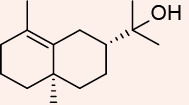 |
D. ammoniacum D. aucheri |
Seed Stem Aerial parts |
[16] [19] |
| 65 | α-eudesmol |  |
D.
ammoniacum D. aucheri |
Seed Stem Aerial parts |
[16] [19, 24] |
| 66 | β-eudesmol |  |
D. ammoniacum | Seed Stem |
[16] |
| 67 | sesquicineol-2-one | 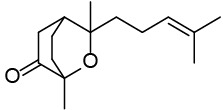 |
D. ammoniacum | Seed Stem |
[16] |
| 68 | germacrene D-4-ol |  |
D. aucheri | Aerial part | [19] |
| 69 | α-cadinol |  |
D.
ammoniacum D. aucheri D. glabrum |
Stem Seed Aerial parts Root |
[16] [19] [23] |
| 70 | δ-cadinol |  |
D. glabrum | Root | [23] |
| 71 | spathulenol |  |
D.
ammoniacum D. aucheri |
Fruit Seed Stem Seed Stem |
[16, 22] [20] |
| 72 | caryophyllene oxide |  |
D. ammoniacum D. aucheri |
Fruit Seed Stem Leaf Seed Stem |
[16, 17, 22] [20] |
| 73 | 4-methylene-5-hexenal |  |
D. ammoniacum | Stem | [18] |
| 74 | 6-methyl-5-hepten-2-one |  |
D. ammoniacum | Stem | [18] |
| 75 | allyl tiglate |  |
D. ammoniacum | Stem | [18] |
| 76 | nerolidyl acetate |  |
D. ammoniacum | Stem | [16] |
| 77 | ammoresinol |  |
D. ammoniacum | Aerial parts | [25] |
| 78 | nonanol | D. ammoniacum | Aerial parts | [15] | |
| 79 | camphor |  |
D. ammoniacum | Aerial parts | [15] |
| 80 | trans-2-caren-4-ol |  |
D. ammoniacum | Fruit | [22] |
| 81 | β-cyclocitral | 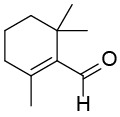 |
D. ammoniacum | Fruit | [22] |
| 82 | piperitenone oxide | 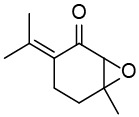 |
D. ammoniacum | Fruit | [22] |
| 83 | (E)-2-nonenal | D. ammoniacum | Stem | [18] | |
| 84 | β-citronellol |  |
D. ammoniacum | Aerial parts | [15] |
| 85 | β-damascenone |  |
D. ammoniacum | Aerial parts | [15] |
| 86 | cedr-8[15]-ene |  |
D. ammoniacum | Aerial parts | [15] |
| 87 | cubenol |  |
D. aucheri D. glabrum |
Aerial
parts Root |
[19] [23] |
| 88 | thujopsene |  |
D. ammoniacum | Aerial parts | [15] |
| 89 | ylangene |  |
D. glabrum D. aucheri |
Aerial
parts Seed Stem |
[21] [20] |
| 90 | nerylacetone |  |
D. ammoniacum | Aerial parts | [15, 17] |
| 91 | geranyl acetone |  |
D. glabrum | Aerial
parts Root |
[21] [23] |
| 92 | (E)-tagetone |  |
D. ammoniacum | Fruit | [22] |
| 93 | (Z)-tagetone |  |
D. ammoniacum | Fruit | [22] |
| 94 | (Z)-ocimenone |  |
D. ammoniacum | Fruit | [22] |
| 95 | (E)-ocimenone |  |
D. ammoniacum | Fruit | [22] |
| 96 | α-bisabolene |  |
D. ammoniacum | Aerial parts | [15] |
| 97 | β-bourbonene | 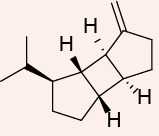 |
D. aucheri D. ammoniacum |
Seed Stem Fruit |
[20] [22] |
| 98 | italicene |  |
D. ammoniacum | Fruit | [22] |
| 99 | di-epi-α-cedrene |  |
D. ammoniacum | Fruit | [22] |
| 100 | α-longipinene |  |
D. ammoniacum | Fruit | [22] |
| 101 | α-cedrene |  |
D. ammoniacum | Aerial parts | [15] |
| 102 | β-cedrene |  |
D.
glabrum D. ammoniacum |
Aerial parts Fruit |
[21] [22] |
| 103 | β-barbatene |  |
D. ammoniacum | Fruit | [22] |
| 104 | α-humulene |  |
D. aucheri D. ammoniacum |
Aerial
parts Seed Stem Fruit |
[17, 18] [22] |
| 105 | ar-curcumene |  |
D. ammoniacum | Fruit | [22] |
| 106 | germacrene D |  |
D. aucheri D. ammoniacum |
Aerial
parts Stem Seed Seed Stem Fruit |
[17, 18] [16, 22] |
| 107 | germacrene B | 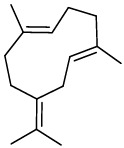 |
D.
aucheri D. glabrum |
Aerial parts Aerial parts Root |
[19] [21, 23] |
| 108 | bicyclogermacrene | 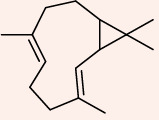 |
D. ammoniacum | Fruit Seed |
[16, 22] |
| 109 | cuparene |  |
D.
glabrum D. aucheri D. ammoniacum |
Aerial
parts Sead Stem Fruit |
[21] [20] [24] |
| 110 | α-cadinene |  |
D. ammoniacum | Fruit Stem |
[16, 22] |
| 111 | 2-nonanone |  |
D. ammoniacum | Stem | [16] |
| 112 | (Z)-hexadec-11-enal | D. ammoniacum | Stem | [16] | |
| 113 | hexadecanal | D. ammoniacum | Stem | [16] | |
| 114 | ethyl linoleate | D. ammoniacum | Stem | [16] | |
| 115 | (Z,E)-farnesal |  |
D. ammoniacum | Aerial parts | [15] |
| 116 | pentadecanal | D. ammoniacum | Aerial parts | [15] | |
| 117 | dodecyl methacrylate |  |
D. ammoniacum | Aerial parts | [15] |
| 118 | 17-octadecenal | D. ammoniacum | Aerial parts | [15] | |
| 119 | 13-tetradecenal | D. ammoniacum | Aerial parts | [15] | |
| 120 | tetradecanal |
D. glabrum D. ammoniacum |
Aerial
parts Stem Seed |
[21] [16] |
|
| 121 | trans-sesquilavandulol |  |
D. ammoniacum | Seed Stem |
[16] |
| 122 | neophytadiene |  |
D. ammoniacum | Aerial parts | [15, 17] |
| 123 | neocembren |  |
D. ammoniacum | Aerial parts | [15] |
| 124 | (E)-5-undecen-3-yne |  |
D. ammoniacum | Fruit | [22] |
| 125 | (Z)-(E)-farnesene |  |
D. ammoniacum | Aerial parts | [22] |
| 126 | trans-β-farnesene |  |
D. ammoniacum | Seed | [16] |
| 127 | n-hexadecanoic acid |
D. ammoniacum D. aucheri |
Aerial parts | [15] [19] |
|
| 128 | kopetdaghin A |  |
D. kopetdaghense | Aerial parts | [2, 26] |
| 129 | kopetdaghin B |  |
D. kopetdaghense | Aerial parts | [26] |
| 130 | kopetdaghin C |  |
D. kopetdaghense | Aerial parts | [2, 26] |
| 131 | kopetdaghin D |  |
D. kopetdaghense | Aerial parts | [2, 26] |
| 132 | kopetdaghin E |  |
D. kopetdaghense | Aerial parts | [2, 26] |
| 133 | hexadecan | D. aucheri | Aerial parts | [21] | |
| 134 | decanol | D. ammoniacum | Stem | [18] | |
| 135 | heptadecanoic acid | D. ammoniacum | Fruit | [22] | |
| 136 | oleic acid | D. ammoniacum | Aerial parts | [15] | |
| 137 | 2,5-dimethyltetrahydrofuran |  |
D. ammoniacum | Leaf Stem |
[17] |
| 138 | methylbenzene |  |
D. ammoniacum | Leaf Stem |
[17] |
| 139 | cyclohexane, 1,3-dimethyl, trans |  |
D. ammoniacum | Leaf Stem |
[17] |
| 140 | valeraldehyde | D. ammoniacum | Leaf Stem |
[17] | |
| 141 | octane | D. ammoniacum | Leaf Stem |
[17] | |
| 142 | imidazole-5-carboxylic acid, 2-amino |  |
D. ammoniacum | Leaf Stem |
[17] |
| 143 | butyl acetate |  |
D. ammoniacum | Leaf Stem |
[17] |
| 144 | cyclohexane, 1,2-dimethyl, cis |  |
D. ammoniacum | Leaf Stem |
[17] |
| 145 | N,N-dimethyl cyclobutane-1,1-bis(methylamine) |  |
D. ammoniacum | Leaf Stem |
[17] |
| 146 | furfural |  |
D. ammoniacum | Leaf Stem |
[17] |
| 147 | deuteroacetone |  |
D. ammoniacum | Leaf Stem |
[17] |
| 148 | styrene |  |
D. ammoniacum | Leaf Stem |
[17] |
| 149 | 1-methyldodecylamine |  |
D. ammoniacum | Leaf Stem |
[17] |
| 150 | aziridine, 1-(2-buten-2-yl) |  |
D. ammoniacum | Leaf Stem |
[17] |
| 151 | sabinene |  |
D. ammoniacum | Leaf Stem |
[17] |
| 152 | decane | D. ammoniacum | Leaf Stem Seed |
[17, 18] | |
| 153 | acetamide, 2-chloro |  |
D. ammoniacum | Leaf Stem |
[17] |
| 154 | 2-butylamine |  |
D. ammoniacum | Leaf Stem |
[17] |
| 155 | phenyl acetaldehyde |  |
D. ammoniacum | Leaf Stem |
[17] |
| 156 | 2-amino-4-hydroxypteridine-6-carboxylic acid |  |
D. ammoniacum | Leaf Stem |
[17] |
| 157 | benzenamine, N-methyl-2-(2-propenyl) |  |
D. ammoniacum | Leaf Stem |
[17] |
| 158 | undecane | D. ammoniacum | Leaf Stem Seed |
[17, 18] | |
| 159 | limonene oxide |  |
D. ammoniacum | Leaf Stem |
[17] |
| 160 | isopropyl isocyanate |  |
D. ammoniacum | Leaf Stem |
[17] |
| 161 | 2-hexanamine, 4-methyl |  |
D. ammoniacum | Leaf Stem |
[17] |
| 162 | 2,6-dimethyl-4-pyrone | 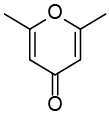 |
D. ammoniacum | Leaf Stem |
[17] |
| 163 | dodecane | D. ammoniacum | Leaf Stem |
[17] | |
| 164 | 2,4-hexadiene, 3-methyl |  |
D. ammoniacum | Leaf Stem |
[17] |
| 165 | β-fenchyl alcohol |  |
D. ammoniacum | Leaf Stem |
[17] |
| 166 | homarine |  |
D. ammoniacum | Leaf Stem |
[17] |
| 167 | 2-(N,N-dimethyl hydrazino) cyclohexane carbonitrile |  |
D. ammoniacum | Leaf Stem |
[17] |
| 168 | phenol, 4-(2-aminopropyl) |  |
D. ammoniacum | Leaf Stem |
[17] |
| 169 | 2-oxo-3-methyl-cis-perhydro-1,3-benzoxazine |  |
D. ammoniacum | Leaf Stem |
[17] |
| 170 | trans-carveol |  |
D. ammoniacum | Leaf Stem |
[17] |
| 171 | benzene, (2-fluoro-2-methoxycyclopropyl) |  |
D. ammoniacum | Leaf Stem |
[17] |
| 172 | 2(1H)-naphthalenone, octahydro-8a-methyl, trans |  |
D. ammoniacum | Leaf Stem |
[17] |
| 173 | p-methoxyamphetamine |  |
D. ammoniacum | Leaf Stem |
[17] |
| 174 | 2-cyclohexen-1-one, 2-methyl-5-(1-methylethenyl) |  |
D. ammoniacum | Leaf Stem |
[17] |
| 175 | 2-methyl amphetamine |  |
D. ammoniacum | Leaf Stem |
[17] |
| 176 | 2-methoxy amphetamine |  |
D. ammoniacum | Leaf Stem |
[17] |
| 177 | tridecane |
D.
ammoniacum D. glabrum |
Leaf Stem Aerial parts |
[17] [21] |
|
| 178 | benzenemethanol, alpha-(1-aminoethyl) |  |
D. ammoniacum | Leaf Stem |
[17] |
| 179 | naphthalene, 1,2-dihydro-1,1,6-trimethyl |  |
D. ammoniacum | Leaf Stem |
[17] |
| 180 | rimantadine |  |
D. ammoniacum | Leaf Stem |
[17] |
| 181 | heptadecane | D. ammoniacum | Leaf Stem |
[17] | |
| 182 | calarene |  |
D. ammoniacum | Leaf Stem |
[17] |
| 183 | 1-[a-(1-adamantyl) benzylidene] thiosemicarbazide |  |
D. ammoniacum | Leaf Stem |
[17] |
| 184 | benzenemethanol, 3-hydroxy-alpha-[(methylamino) methyl] |  |
D. ammoniacum | Leaf Stem |
[17] |
| 185 | 1 S-cis-calamenene |  |
D. ammoniacum | Leaf Stem |
[17] |
| 186 | calamenene |  |
D. glabrum | Root | [23] |
| 187 | aptrol (4-Methylamphetamine) |  |
D. ammoniacum | Leaf Stem |
[17] |
| 188 | farnesol |  |
D. ammoniacum D. aucheri |
Leaf Stem Seed Seed Stem |
[17, 18] [20] |
| 189 | benzenemethanol, 4-hydroxy-alpha-[(methylamino) methyl] |  |
D. ammoniacum | Leaf Stem |
[17] |
| 190 | N-methyl-propylamine | D. ammoniacum | Leaf Stem |
[17] | |
| 191 | pentadecane | D. ammoniacum | Leaf Stem |
[17] | |
| 192 | 2-hexanamine, 5-methyl |  |
D. ammoniacum | Leaf Stem |
[17] |
| 193 | benzenemethanol, 2-(2-aminopropoxy)-3-methyl |  |
D. ammoniacum | Leaf Stem |
[17] |
| 194 | 2-propanamine |  |
D. ammoniacum | Leaf Stem |
[17] |
| 195 | 2-aminononadecane | D. ammoniacum | Leaf Stem |
[17] | |
| 196 | methanimidamide, N,N-dimethyl-N-phenyl |  |
D. ammoniacum | Leaf Stem |
[17] |
| 197 | methylpent-4-enylamine |  |
D. ammoniacum | Leaf Stem |
[17] |
| 198 | cyclobutanol |  |
D. ammoniacum | Leaf Stem |
[17] |
| 199 | hexahydro farnesyl acetone |  |
D. ammoniacum | Leaf Stem |
[17] |
| 200 | n-hexylmethylamine | D. ammoniacum | Leaf Stem |
[17] | |
| 201 | ethylene bromohydrin | D. ammoniacum | Leaf Stem |
[17] | |
| 202 | didodecyl phthalate |  |
D. ammoniacum | Leaf Stem |
[17] |
| 203 | 3-propoxyamphetamine |  |
D. ammoniacum | Leaf Stem |
[17] |
| 204 | glycine, N-(N-acetyl-L-alanyl) butyl ester |  |
D. ammoniacum | Leaf Stem |
[17] |
| 205 | 2-propenamide |  |
D. ammoniacum | Leaf Stem |
[17] |
| 206 | 2-heptanol, 6-amino-2-methyl |  |
D. ammoniacum | Leaf Stem |
[17] |
| 207 | benzene ethanamine, 4-fluoro-beta,3-dihydroxy-N-methyl |  |
D. ammoniacum | Leaf Stem |
[17] |
| 208 | 1H-Indole-3-ethanamine, 6-fluoro-beta-methyl |  |
D. ammoniacum | Leaf Stem |
[17] |
| 209 | nonadecane | D. ammoniacum | Leaf Stem |
[17] | |
| 210 | eicosane | D. ammoniacum | Leaf Stem |
[17] | |
| 211 | cyclotrisiloxane, hexamethyl |  |
D. ammoniacum | Leaf Stem |
[17] |
| 212 | diglucosyl caffeoyl ester |  |
D. glabrum | Fruit Seed |
[27] |
| 213 | 4-O-β-D-glucopyranosylcaffeic acid |  |
D. glabrum | Fruit Seed |
[27] |
| 214 | azeroside A |  |
D. glabrum | Root | [26-28] |
| 215 | echisoside |  |
D. glabrum | Root | [26-28] |
| 216 | pleoside |  |
D. glabrum | Root | [26-28] |
| 217 | hyrcanoside | 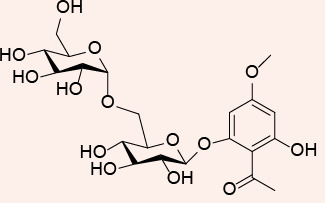 |
D. glabrum | Root | [26-28] |
| 218 | azeroside B |  |
D. glabrum | Root | [26-28] |
| 219 | 7,8-dihydroferulic acid-4-O-β-D-glucopyranoside |  |
D. glabrum | Root | [29, 30] |
| 220 | ferulic acid-4-O-β-D-glucopyranoside |  |
D. glabrum | Root | [30, 32] |
| 221 | 4-methoxy-6-hydroxyacetophenone-2-O-β-D-gentiobioside |  |
D. hyrcanum | Root | [33] |
| 222 | 1(2-Hydroxy-4-methoxy)- 3,7,11- trimethyl-3-vinyl-6(E), 10 dodecadiene- 1- dione |  |
D. hyrcanum | Root | [33] |
| 223 | chlorogenic acid |  |
D. glabrum | Root | [30] |
| 224 | cynarin |  |
D. glabrum | Root | [30] |
| 225 | 4,5-diCQA (4,5-dicaffeoylquinic acid) |  |
D. glabrum | Root | [30] |
| 226 | 6,7,8-trihydroxycoumarin |  |
D. glabrum | Root | [30, 34] |
| 227 | 2,3-dihydro-7-methoxy-2S*,3R*-dimethyl-2-[4,8-dimethyl-3(E),7-nonadienyl]-furo[3,2-c]coumarin |  |
D. hyrcanum | Root | [33] |
| 228 | 2,3-dihydro-7-methoxy-2R*,3R*dimethyl-2-[4,8-dimethyl-2283(E),7-nonadienyl]-furo[3,2-c]coumarin |  |
D. hyrcanum | Root | [33] |
| 229 | umbelliferone 7-O-β-D-glucoside (skimmin) |  |
D. glabrum | Fruit Seed |
[27] |
ETHNOBOTANICAL USES OF DDorema spp.
Among 12 species of Dorema, seven have been used in ethnobotany for many decades as a remedy for various human and animal illnesses. These applications of individual Dorema species are shown in Table 3. The most popular species, with the highest number of citations were D. ammoniacum and D. aucheri.
Table 3.
Some of the most important ethnobotanical and traditional uses of Dorema species in different countries
| No | Dorema species | Vernacular name | Country | Part used | Ethnobotanical and traditional uses | Ref |
|---|---|---|---|---|---|---|
| 1 | D. aitchisonii | - | The former Soviet Union | Shoot | The water extract from the young shoots is used to treat diseases of the stomach. | [7] |
| 2 | D. ammoniacum | Kandal | Iran | Gum, root | Cystitis, digestive, treatment of colic, treatment of furuncles, expectorant, anthelmintic, emmenagogue, anticovulsion | [6] |
| Koma | Iran | Resin | Antacid, digestive, treatment of colic, furuncles, expectorant, anthelmintic, emmenagogue and anticovulsion | [46] | ||
| Anghuzeh | Iran | Latex | Asthma, expectorant, bronchitis, stomachache | [37] | ||
| Ammoniacum | Jordan | Resin | Incense, blood sugar reduction | [35] | ||
| Kama eshterk | Iran | Gum | Healing infected wound and infection, acne and abscess | [36] | ||
| Ganda ferooza | Afghanistan | Flowers | Treatment of diarrhea, peptic ulcer and other gastric diseases | [41] | ||
| Ooshi | Pakistan | Gum | Abortifacient | [47] | ||
| Oshagh | Iran | Gum | Analgesic, antidote for toxins, laxative, sciatic pain | [38] | ||
| Kama eshterk | Iran | Gum | Improvement of infectious wounds and infection, abscess in sheep and goats | [48] | ||
| 3 | D. aucheri | Kal | Iran | Latex | Asthma, expectorant, bronchitis, making gum | [37] |
| Bilhar | Iran | Young aerial part | Parasites of digestive system, constipation, use as vegetable, young stems are pickled | [12] | ||
| Kama, Eshterk, Balhareshterk | Iran | Gum | Healing infected wound and infection, gasteralgia | [36] | ||
| Balhar, Kama, eshterk | Iran | Gum | Improvement of infectious wounds and infection in sheep | [48] | ||
| Zou | Iran | Root | Burn healing, cornicide | [43] | ||
| 4 | D. aureum | Oshtork | Iran | Gum | Abortion, infection | [49] |
| 5 | D. glabrum | - | Azerbaijan Republic | Gum-resin | Diuretic and anti-diarrheal agent as well as for the treatment of bronchitis and catarrh, cure of cancer | [15] |
| 6 | D. hyrcanum | - | The former Soviet Union | Resin | As plasters to stop bleeding and to treat injuries in horses. | [7] |
| 7 | D. sabulosum | Ilyan | Uzbekistan | Root and stem | Roots used as diuretic and for head and respiratory organs. tincture from green stem used as a remedy for head and heart illnesses. | [45] |
Dorema ammoniacum has been historically reputed in the folk medicine as a natural remedy for a variety of diseases and known as a rich source of a medicinal gum-resin commonly known as ammoniacum or gum ammoniac. The gum-resin is found in cavities in stems, roots and petioles [5]. In Persia, D. ammoniacum (commonly known as Kandal, Vasha and Ushagh.), has a broad spectrum ethnobotanical applications such as anticolic, antifuruncle, expectorant, anthelmintic, emmenagogue agent, anticonvulsant, analgesic, antidote for toxins and laxative. Also, it has been used for treating asthma, bronchitis, stomachache, high blood sugar, infected wounds and infections, acne, abscess, and sciatic pain [6, 35-38].
Western and Indian herbalists recommended it as an antispasmodic, expectorant, diaphoretic and emmenagogue agent and also for treatment of catarrh, asthma, chronic bronchitis and persistent coughing [39, 40].
Jordanian herbalist recommended the usage of the resin of D. ammoniacum as incense and blood sugar reducer [35].
In Afghanistan, herbal medicine has been used under the name of Unani medicine for centuries. In different parts of Kabul, there are numerous Unani or Loqmani pharmacies locally called “Attari” where Hakims are prescribing the flowers of D. ammoniacum for the treatment of diarrhea, peptic ulcer, and other gastric diseases [41].
In Pakistan, D. ammoniacum has been used to treat dysentery and skin diseases by local people particularly in Baluchistan province [42].
In Iranian folk medicine, D. aucheri is used against asthma, bronchitis, parasites of digestive system, constipation, burns and infected wounds young leaves and branches are used for making a locally popular pickle called “Bilhar Pickle” and soups [12, 36, 37, 43].
Based on the folk beliefs of Azerbaijan and Armenian people, Dorema species can treat many abnormalities especially catarrh, bronchitis and diarrhea and also can act as diuretic [44]. Besides, they use D. glabrum for many illnesses especially various types of cancer [23].
In former times, some Dorema species were consumed in the former Soviet Union. The resins of D. hyrcanum were used by the local population as plasters to stop bleeding and to treat injuries in horses. The water extract from the young shoots of D. aitchisonii is used to treat diseases of the stomach [7].
In Uzbekistan, milky latex from the roots of D. sabulosum is used as diuretic and for head and respiratory organs. Tincture from green stem is useful for head and heart diseases [45].
NATURE OF D. ammoniacum DESCRIBED IN ITM
In all of ITM literatures the Mizaj (temperament) of Dorema is mentioned as hot and dry [50-57]. Avicenna and other ITM scientists believed that Dorema is a purgative (for bile, yellow bile, and phlegm), resolvent (mohallel), desiccant, deobstruent (mofatteh), laxativeand attractive agent [50-57].
Droma ammoniacum has been known as a rich source of ammoniacum or gum ammoniac. This medicinal gum-resin has been described by Dioscorides as following:
“It is also called “agasyllon”, “criotheos”, or “heliastrus”, and the Romans call it “gutta”. Its smell is similar to castor odor with bitter taste.it has a good color, is not woody, without stones, similar to frankincense in little clots, clear and thick, without filth, this type is called “thrausma” and its earthy or stony kind is called “phurama” [51].
USES OF D. ammoniacum IN ITM
According to ITM texts, D. ammoniacum, D. aucheri and D. aureum are the most usable species with similar effects, so in the following sections, we have only mentioned and categorized D. ammoniacum medicinal activities on target organs according to the text books, listed in Table 4.
Table 4.
Major ITM books and their authors that described medicinal properties of Dorema spp.
| Book | Language | Author | Living period |
|---|---|---|---|
| Al-Qânun fi al-Tibbe | Arabic | Ibn Sina | 980-1037 A.D. |
| Zakhireh khârazmshâhi | Persian | Jorjâni | 1042-1136 A.D. |
| Al-Aghrâz al-Tibbe wa al-Mabâhethi al-Alâiiah | Persian | Jorjâni | 1042-1136 A.D. |
| Al-Jâmee le Mofradât al-Adwiah wa al-Aghziah | Arabic | Ibn Al-Baytâr | 1193-1248 A.D. |
| Tadhkirat Oli al-Albâb wa al-Jâme le al-Ajb al-Ujâb | Arabic | Antaki | 1535-1599 A.D. |
| Hadiqat al-Azhâr fi Mâhiyyat al-ushb wa al-uqqâr | Arabic | Ghasani | 1547-1611 A.D. |
| Al-Mujaz fi'l-Tibb | Arabic | Ibn Nafis Qarshi | 1213- 1288 A.D. |
| Tohfah al-Momenin | Persian | Husseini Tonekaboni | 17th century |
| Makhzan al-Adwiah | Persian | Aqili Khorasani | 18th century |
1. Liver and spleen
One of the most traditional uses of Dorema is in liver and spleen disorders.
The liniment of D. ammoniacum with vinegar (acetum) on the skin of spleen and liver is an effective remedy for hepatitis, splenitis and sclerosis of liver and stiffness of spleen. Oral administration of this combination has the same effect for mentioned disease. Besides, Dorema has been used for treating liver obstructions [52, 55, 57].
2. Gastrointestinal system
In the most of the investigated ITM books, Dorema spp. has been recommended as an anthelmintic agent against gastrointestinal worms and tinea [52, 54, 55, 57], as a laxative for treating constipation [56] and as a purgative agent for cleansing the stomach from the phlegmatic excreta [53, 58]. In addition, many ITM scientists believed that Dorema spp. treats hemorrhoids and anal disorders because of its deobstuent effect on the rectal veins [54, 57].
3. Upper respiratory tract
The therapeutic properties of Dorema spp. on theupper respiratory tract are paid attention by many scientists in ITM. They described it as a good remedy for orthopnea, dyspnea, diphtheria and specifically asthma. Ibn Nafis Qarashi in his book (Al-Mujaz fi’l-Tibb) recommended that a linctus of Dorema with honey or mucilage of barley is useful for the mentioned diseases, as well as scrofula [55]. This mixture is frequently mentioned in other ITM books such as Makhzan al-Adwiah, Tohfah al-Momeninand etc. [52, 54, 55, 57]. The above mixture was used for purgation of the lungs from phlegmatic humors, too [52, 57].
4. Eyes
In all ITM records, treating ocular problems by Dorema preparations have been reported. A collyrium (kohl) of Dorema was used for improving the thickness of eyelids, treating trachoma, leukoma (opacity of the cornea) ophthalmia and stye [52, 55, 57, 58]. Dorema is an effective remedy for moisturizing roughness of eyelids [52, 55, 58]. In addition, it dries up eye moisture [52, 55, 57].
5. Central nervous systems
Due to descanting effects of Dorema, it was described as a purgation agent to clean the brain from phlegm and other humors [52]. Taking a combination of Dorema with honey or beer is a useful remedy for epilepsy and insensibility (numbness) spasms [52, 57]. Also gurgling a warm watery solution of the plant is suitable for cleaning the brain from waste phlegm and humors, dizziness, paralysis, facial paralysis and vertigo [52].
6. Genitourinary system
Dorema spp. has diuretic and emmenagogic properties, therefore, it has been used as a treatment for dysuria and as an abortifacient agent [52, 54, 55]. Dorema preparations have also been reported to be useful for nephrolith and cystolith [52, 57]. Some ITM scientists have recommended it as a remedy for the hardness of testicles and orchitis as well [52].
7. Skin
Dorema has been described to have the property of improving complexion; Therefore, it was particularly used for vitiligo, melisma and freckles [52, 57]. For this purpose, the herb was applied with olive oil on the affected area. Furthermore, many ITM scientists such as Ibn Nafis Qarshi and Jorjani have mentioned the plant as a cure for various types of wounds, ulcers and specifically scars; as Jorjani has written:” Dorema plaster wears away decayed flesh and regenerates new one” [52, 55, 57].
8. Joints and muscles
There are several records on the traditional use of Dorema spp. for joints. For instance, Jorjani has mentioned it for sciatic nerve pain (sciatica). It is also claimed as a cure for arthralgia and stiffness of joints, particularly when prescribed topically with honey [52, 55].
PHARMACOLOGICAL ASPECTS
So far, various pharmacological activities have been reported from Dorema spp., includinganti-microbial, anti-bacterial, anti-plasmodial, anti-fungal, cytotoxic, anti-inflammatory, free radical scavenging, hypolipidemic, anticonvulsant and anti-diabetic activities, as well as effects on pituitary gonad axis hormones. These reports have been mentioned in Tables 5 and 6.
Table 5.
In vitro studies of Dorema spp.
| Species | Part used | Type of extraction | Activity | Tested pathogen/cell | Result(s) | Ref |
|---|---|---|---|---|---|---|
| D. aucheri | Gum | Dichloromethane, methanol extract | Anti-microbial activity | E. coli, K. pneumoniae, P. aeruginosa, C. albicans | MIC: 20 and 40 mg/mL | [59] |
| D. ammoniacum | Oleogum resin | Dichloromethane and methanol extract | Anti-bacterial and anti-fungal | G+ and G– | C: 500 and 1000 µg/mL | [60] |
| D. ammoniacum | Aerial parts | Methanol extract | Anti-microbial activity |
S.
aureus Enterococcus sp. C. albicans E. coli |
MIC:78 µg/mL | [61] |
| D. aucheri | Aerial parts | Methanol extract | Anti-microbial and anti-oxidative |
B. cereus, S. aureus, E. coli S. enterica |
MIC: 10-50 mg/mL | [62] |
| D. ammoniacum | Ripe fruit | Essential oil | Anti-microbial activity |
B.
subtilis S. epidermidis |
MIC: 3.75 mg/mL | [22] |
| D. aucheri | Leaf | Ethanol extract | Anti-bacterial activity |
S. pyogenes P. aeruginosa |
MIC and MBC. 30 and 40 mg/mL | [63] |
| D. aucheri | Aerial parts | Hydro-alcoholic extract | Cytotoxicity | Artemia urmiana larve (lethaling brine shrimp) | LC50 76.50 ± 0.60 μg/mL | [64] |
| D. kopetdaghense | Aerial parts | Kopetdaghins A, C and E | Anti-inflammatory effect | J774A.1 murine macrophages | IC50: 474.1 ± 0.9, 496.4 ± 0.7 and 514.3 ± 0.4 μg/mL | [2] |
| D. aucheri | Aerial parts | Water/ethanol extract | Anti-coccidial effects | Fecal samples | lowest (1.60) and the highest body weight (1.75) FCR | [65] |
| D. aucheri | Roots | EtOAc extract | No scavenging, and anti-bacterial activities |
E. coli, S. flexneri S. aureus B. subtilis |
MIC: 0.156, E. coliIC50: 113.74 ± 0.21and 597.64 ± 0.33 μg/mL | [66] |
| D. aucheri | Aerial parts | Hydroalcoholic and aqueous extracts | Genotoxicity evaluation | HepG2 cell line | Genotoxic effect: 500 μg/mL | [67] |
| D. glabrum | Root | n-hexane extracts | Apoptosis and cell cycle arrest | Cancer cells | IC50: 6.4,4.6 μg/mL | [68] |
| D. glabrum | Seed | Methanol extracts | Apoptotic effects | WEHI-164 cells | Apoptosis and antiproliferative properties | [69] |
| D. ammoniacum | Oleogum resin | Methanol extracts | Cytotoxic effects | Saccaromyces cerevisiae | IC12: 3.14 mg/mL | [70] |
| D. aucheri | Aerial part | Methanol extracts | Cytotoxic activity | HepG2 and A549 cells | IC50: 20.09, 48.65 μg/mL | [71] |
| D. glabrum | Seed | Methanol extracts | Cytotoxic effects | WEHI-164 cells, mouse Fibrosarcoma cell line and L929 normal cells | IC50: 50 μg/mL in 36 hours | [72] |
| D. glabrum | Seeds | Methanol extract | Geno/cytotoxicty and apoptotic | CAOV-4 cells | IC50: 99.7, 87.3, 70.03 μg/mL at 48 h | [73] |
| D. glabrum | Roots | Essential oil | Free radical scavenging | DPPH assay | RC50: 2.24 mg/mL | [23] |
| D. glabrum | Aerial parts | Methanol fraction | Antioxidant | DPPH assay | IC50: 53.3 ± 4.7 μg/mL | [21] |
Table 6.
In vivo studies of Dorema spp.
| Species | Parts used | Type of extraction | Activity | Study design | Result(s) | Ref |
|---|---|---|---|---|---|---|
| D. aucheri | Leaves | Hydroalcoholic extract | Hypolipidemic | Diabetic rats model; orally; 200 mg/kg for 4 weeks; a randomized controlled clinical trial | Useful in treatment of diabetes, remarkable change in serum lipid profiles | [73] |
| D. hyrcanum | Roots | Methanol extract | Antiplasmodial effect | Mice model; injection ; 10 mg/mL for 4 days 4-day suppressive test against nicd strain of in mice | Good suppression plasmodium berghei infection activity, inhibiting 68.1% of the parasite growth | [33] |
| D. aucheri | Leaves | Ethanol95% | Hepatotoxicity | Albino mice model; injections; 3.2 mL/kg; three times every 48 hours | Inflammation of the liver tissue, cell proliferation, cholestasis, and a great release of liver enzymes | [74] |
| D. aucheri | Aerial parts | Essential oil | Anti-diabetic effect | Patients with type ii diabetes; randomized clinical trial; 500 mg for 45 days | Biological effects through PPAR-γ activation | [24] |
| D. urmiana | Aerial parts | Hydro alcohol extract | Cytotoxicity | Larvae of artemia urmiana; 24 hours; 12 mg rutin/g extract | lc50 76.50 ± 0.60 μg/mL potent brine shrimp lethality | [64] |
| D. aucheri | Leaves | Water/ethanol 95° mixture | Anti-coccidial | Chickens model; orally; after 22 day of age; 30 mg/kg | Effective in control of coccidiosis | [65] |
| D. ammoniacum | Gum | Water extract | Anticonvulsant activity | Male albino mice model; 700 mg/kg; injection | Showed significant anticonvulsant activity | [75] |
| D. aucheri | Root | Hydroalcoholic extract | Effects on pituitary gonad axis hormones | Adult male rat model; orally; 200 mg/kg for 28 days | Increased lh concentrations | [76] |
CONCLUSION
Ethnobotanical and traditional medicines are considered as valuable approaches for discovering new medicines because of antiquity medical usage of them over generations. In the current review, the beneficial properties and applications of Dorema spp. Was investigated in ITM books and modern pharmacological studies. The genus Dorema, especially D. ammoniacum known as “ushaq” has been used in folklore and Islamic traditional medicine as a treatment for a wide range of disorders, such as gastrointestinal, upper respiratory tract and central nervous systems’ problems. Besides, many pharmacological activities including anti-microbial, anti-inflammatory, antioxidant, cytotoxicity, anticonvulsant, anti-diabetic and hypolipidemic activities have been reported in modern medicine. These species contain various constituents such as terpenes, coumarins and phenolic compounds. However, more studies, particularly clinical trials, are necessary to fill existing gaps in our knowledge of various aspects of these species.
ACKNOWLEDGEMENTS
This work was supported by grants from Research Affairs of Mashhad University of Medical Sciences, Mashhad, Iran.
Footnotes
CONFLICT OF INTEREST
The authors declare that there are no conflicts od interest.
REFERENCES
- 1.Mozaffarian V. [Flora of Iran] Research Institute of Forests and Rangelands; Tehran: 2007. Chapter 54, Umbelliferae; pp. 368–74. Persian. [Google Scholar]
- 2.Rabe SZT, Iranshahi M, Rastin M, Rabe SZT, Mahmoudi M. Anti-inflammatory effect of new kopetdaghins A, C and E from Dorema kopetdaghense. Food Agric Immunol. 2015;26(3):430–9. doi: 10.1080/09540105.2014.950200. [DOI] [Google Scholar]
- 3.Amin GR. Popular medicinal plants of Iran. 1. Iranian Research Institute of Medicinal Plants; Tehran: 1991. p. 230. [Google Scholar]
- 4.Ali GB, Mahdi F. The possibility of crop cultivation and utilization of edible gum from herb (Dorema ammoniacum D. Don) in dryland farming. J Agric Sci. 2015;60(3):369–80. doi: 10.2298/JAS1503369G. [DOI] [Google Scholar]
- 5.Langenheim JH. Plant resins: chemistry, evolution, ecology and ethnobotany. Timber Press; Portland: 2003. pp. 123–9. [Google Scholar]
- 6.Amiri MS, Joharchi MR. Ethnobotanical investigation of traditional medicinal plants commercialized in the markets of Mashhad, Iran. Avicenna J Phytomed. 2013;3(3):254–71. [PMC free article] [PubMed] [Google Scholar]
- 7.Schischkin BK. [Flora SSSR. 17] Izd-vo Akademii Nauk SSSR; Leningrad: 1951. pp. 155–65. Russian. [Google Scholar]
- 8.Pimenov MG, Leonov MV, Constance L. The genera of the Umbelliferae: a nomenclator. Royal Botanic Gardens; London: 1993. p. 156. [Google Scholar]
- 9.Ajani Y, Ajani A, Cordes JM, Watson MF, Downie SR. Phylogenetic analysis of nrDNA ITS sequences reveals relationships within five groups of Iranian Apiaceae subfamily Apioideae. Taxon. 2008;57(2):383–401. [Google Scholar]
- 10.Rechinger KH. Umbelliferae. Akademische; Graz: 1987. pp. 379–85. [Google Scholar]
- 11.Amiri MS, Joharchi MR. Ethnobotanical knowledge of Apiaceae family in Iran: a review. Avicenna J Phytomed. 2016;6(6):621–35. [PMC free article] [PubMed] [Google Scholar]
- 12.Mosaddegh M, Naghibi F, Moazzeni H, Pirani A, Esmaeili S. Ethnobotanical survey of herbal remedies traditionally used in Kohghiluyeh va Boyer Ahmad province of Iran. J Ethnopharmacol. 2012;141(1):80–95. doi: 10.1016/j.jep.2012.02.004. [DOI] [PubMed] [Google Scholar]
- 13.Memariani F, Akhani H, Joharchi MR. Endemic plants of Khorassan-Kopet Dagh floristic province in Irano-Turanian region: diversity, distribution patterns and conservation status. Phytotaxa. 2016;249(1):31–117. doi: 10.11646/phytotaxa.249.1.5. [DOI] [Google Scholar]
- 14.Sadeghei Takallo M, Sajjadifar S, Avval MM. Chemical composition of the essential oils from flowers, stems and roots of Dorema ammoniacum D.Don from Iran. Res J Pharm Biol Chem Sci. 2013;4(4):640–4. [Google Scholar]
- 15.Delnavazi MR, Tavakoli S, Rustaie A, Batooli H, Yassa N. Antioxidant and antibacterial activities of the essential oils and extracts of Dorema ammoniacum roots and aerial parts. Res J Pharmacogn. 2014;1(4):11–8. [Google Scholar]
- 16.Hosseini SAR, Naseri HR, Azarnivand H, Jafari M, Rowshan V, Panahian AR. Comparing stem and seed essential oil in Dorema ammoniacum D. Don. from Iran. J Essent Oil Bear Plants. 2014;17(6):1287–92. doi: 10.1080/0972060X.2014.977572. [DOI] [Google Scholar]
- 17.Zandpour F, Vahabi MR, Allafchian AR, Farhang HR. Phytochemical investigation of the essential oils from the leaf and stem of (Apiaceae) in Central Zagros, Iran. J Herb Drugs. 2016;7(2):109–16. [Google Scholar]
- 18.Masoudi S, Kakavand S. Volatile constituents of the aerial parts of Terataenium lasiopentalum (Boiss.) Manden., stems and leaves of Dorema ammoniacum D. Don. and leaves, fruits and stems of Leutea petiolare (DC.) M. Pimen from Iran. J Chil Chem Soc. 2017;62(1):3311–4. doi: 10.4067/S0717-97072017000100001. [DOI] [Google Scholar]
- 19.Masoudi S, Esmaeili A, Ali khalilzadeh M, Rustaiyan A, Moazami N, Akhgar MR, et al. Volatile constituents of Dorema aucheri Boiss., Seseli libanotis (L.) W. D. Koch var. armeniacum Bordz. and Conium maculatum L. three Umbelliferae herbs growing wild in Iran. Flavour Fragr J. 2006;21(5):801–4. doi: 10.1002/ffj.1722. [DOI] [Google Scholar]
- 20.Akbarian A, Rahimmalek M, Sabzalian MR. Variation in essential oil yield and composition of Dorema aucheri Boiss., an endemic medicinal plant collected from wild populations in natural habitats. Chem Biodivers. 2016;13(12):1756–66. doi: 10.1002/cbdv.201600160. [DOI] [PubMed] [Google Scholar]
- 21.Delnavazi MR, Hadjiakhoondi A, Delazar A, Ajani Y, Tavakoli S, Yassa N. Phytochemical and antioxidant investigation of the aerial parts of Dorema glabrum Fisch. & C.A. Mey. Iran J Pharm Res. 2015;14(3):925–31. [PMC free article] [PubMed] [Google Scholar]
- 22.Yousefzadi M, Mirjalili HM, Alnajar N, Zeinali A, Parsa M. Composition and in vitro antimicrobial activity of the essential oil of Dorema ammoniacum D. Don. fruit from Iran. J Serbian Chem Soc. 2011;76(6):857–63. doi: 10.2298/JSC100830074Y. [DOI] [Google Scholar]
- 23.Asnaashari S, Dadizadeh E, Talebpour AH, Eskandani M, Nazemiyeh H. Free radical scavenging potential and essential oil composition of the Dorema glabrum Fisch. C.A. Mey roots from Iran. Bioimpacts. 2011;1(4):241–4. doi: 10.5681/bi.2011.035. [DOI] [PMC free article] [PubMed] [Google Scholar]
- 24.Nahvinejad M, Pourrajab F, Hekmatimoghaddam S. Extract of Dorema aucheri induces PPAR-γ for activating reactive oxygen species metabolism. J Herb Med. 2016;6(4):171–9. doi: 10.1016/j.hermed.2016.09.003. [DOI] [Google Scholar]
- 25.Behpour M, Ghoreishi SM, Khayatkashani M, Soltani N. The effect of two oleo-gum resin exudate from Ferula assa-foetida and Dorema ammoniacum on mild steel corrosion in acidic media. Corros Sci. 2011;53(8):2489–501. doi: 10.1016/j.corsci.2011.04.005. [DOI] [Google Scholar]
- 26.Iranshahi M, Shaki F, Mashlab A, Porzel A, Wessjohann LA. Kopetdaghins A-E, sesquiterpene derivatives from the aerial parts and the roots of Dorema kopetdaghense. J Nat Prod. 2007;70(8):1240–3. doi: 10.1021/np070043u. [DOI] [PubMed] [Google Scholar]
- 27.Eskandani M, Dadizadeh E, Hamishehkar H, Nazemiyeh H, Barar J. Geno/cytotoxicty and apoptotic properties of phenolic compounds from the seeds of Dorema glabrum fisch. C.A. Bioimpacts. 2014;4(4):191–8. doi: 10.15171/bi.2014.019. [DOI] [PMC free article] [PubMed] [Google Scholar]
- 28.Nurmukhamedova MR, Nikonov GK. Glycosides of Dorema hyrcanum. Chem Nat Compd. 1976;12(1):92–3. doi: 10.1007/BF00570207. [DOI] [Google Scholar]
- 29.Bukreeva TV, Pimenov MG. 2,6-Dihydroxy-4-methoxyacetophenone 2-O-β-D-gentiobioside from the roots of Dorema aitchisonii. Chem Nat Compd. 1991;27(5):638–9. doi: 10.1007/BF00630378. [DOI] [Google Scholar]
- 30.Delnavazi MR, Hadjiakhoondi A, Delazar A, Ajani Y, Yassa N. Azerosides A and B: two new phloroacetophenone glycosides from the roots of Dorema glabrum Fisch. & C.A. Mey. Med Chem Res. 2015;24(2):787–96. doi: 10.1007/s00044-014-1138-2. [DOI] [Google Scholar]
- 31.Nykolov N, Iossifova T, Vassileva E, Kostova I, Stoev G. Reverse-phase high pressure liquid chromatographic analysis of hydroxycoumarins in plant extracts. Quantitative determination of hydroxycoumarins in Fraxinus ornus. Phytochem Anal. 1993;4(2):86–8. doi: 10.1002/pca.2800040207. [DOI] [Google Scholar]
- 32.Morikawa T, Imura K, Miyake S, Ninomiya K, Matsuda H, Yamashita C, et al. Promoting the effect of chemical constituents from the flowers of Poacynum hendersonii on adipogenesis in 3T3-L1 cells. J Nat Med. 2012;66(1):39–48. doi: 10.1007/s11418-011-0549-3. [DOI] [PubMed] [Google Scholar]
- 33.Naghibi F, Ghafari S, Esmaeili S, Jenett-Siems K. Naghibione; a novel sesquiterpenoid with antiplasmodial effect from Dorema hyrcanum Koso-Pol. Root, a plant used in traditional medicine. Iran J Pharm Res. 2015;14(3):961–8. [PMC free article] [PubMed] [Google Scholar]
- 34.Kraus C, Spiteller G. Comparison of phenolic compounds from galls and shoots of Picea glauca. Phytochemistry. 1997;44(1):59–67. doi: 10.1016/S0031-9422(96)00388-3. [DOI] [Google Scholar]
- 35.Lev E, Amar Z. Ethnopharmacological survey of traditional drugs sold in the Kingdom of Jordan. J Ethnopharmacol. 2002;82(2-3):131–45. doi: 10.1016/S0378-8741(02)00182-4. [DOI] [PubMed] [Google Scholar]
- 36.Mohamadi N, Sharififar F, Koohpayeh A, Daneshpajouh M. Traditional and ethnobotanical uses of medicinal plants by ancient populations in Khabr and Rouchon of Iran. J Appl Pharm Sci. 2015;5(11):101–7. doi: 10.7324/JAPS.2015.501117. [DOI] [Google Scholar]
- 37.Rajaei P, Mohamadi N. Ethnobotanical study of medicinal plants of hezar mountain allocated in South East of Iran. Iran J Pharm Res. 2012;11(4):1153–67. [PMC free article] [PubMed] [Google Scholar]
- 38.Zarshenas MM, Arabzadeh A, Ajdari Tafti M, Kordafshari G, Zargaran A, Mohagheghzadeh A. Application of herbal exudates in traditional Persian medicine. Galen Med J. 2013;1(2):78–83. [Google Scholar]
- 39.Khare CP. Indian medicinal plants: an illustrated dictionary. Springer; Berlin: 2007. p. 812. [DOI] [Google Scholar]
- 40.Chevallier A. The encyclopedia of medicinal plants. DK; London: 1996. p. 336. [Google Scholar]
- 41.Amini MH, Hamdam SH. Medicinal plants used traditionally in Guldara district of Kabul, Afghanistan. Int J Pharmacogn Chinese Med. 2017;1(3):1–13. doi: 10.23880/IPCM-16000118. [DOI] [Google Scholar]
- 42.Baloch AH, Baloch IA, Haneef-ur-Rehman SRS, Jaffar A. Contribution to the knowledge of ethnobotany of Balochistan, Pakistan. Lasbela Univ J Sci Technol. 2016;1:143–73. [Google Scholar]
- 43.Tahvilian R, Shahriari S, Faramarzi A, Komasi A. Ethno-pharmaceutical formulations in kurdish ethno-medicine. Iran J Pharm Res. 2014;13(3):1029–39. [PMC free article] [PubMed] [Google Scholar]
- 44.Mir-Babayev NF, Gasanov GG, Knight DW. Plants of the Republic of Azerbaijan with potential medicinal applications. Int J Pharmacogn. 1993;31(1):47–54. doi: 10.3109/13880209309082917. [DOI] [Google Scholar]
- 45.Gintzburger G. Rangelands of the arid and semi-arid zones in Uzbekistan. CIRAD; Montpellier: 2003. p. 91. [Google Scholar]
- 46.Emami SA, Nadjafi F, Amine GH, Amiri MS, Khosravi MT, Nasseri M. [Les espèces de plantes médicinales utilisées par les guérisseurs traditionnels dans la province de Khorasan, nord-est de l'Iran] Ethnopharmacologia. 2012;48:48–59. French. [Google Scholar]
- 47.Bibi T, Ahmad M, Ahmadbaloch I, Muhammad S, Manzoor R. Ethnomedicinal uses of plants for child birth and postpartum recovery in District Pishin, Northern Balochistan, Pakistan. Int J Biol Pharm Allied Sci. 2017;6(9):1730–60. [Google Scholar]
- 48.Koohpayeh A, Ghasemi Pirbalouti A, Yazdanpanah Ravari MM, Pourmohseni Nasab E, Arjomand D. Study the ethno-veterinary of medicinal plants in Kerman province, Iran. J Herb Drugs. 2011;2(3):211–6. [Google Scholar]
- 49.Sadeghi Z, Mahmood A. Ethno-gynecological knowledge of medicinal plants used by Baluch tribes, southeast of Baluchistan, Iran. Rev Bras Farmacogn. 2014;24(6):706–15. doi: 10.1016/j.bjp.2014.11.006. [DOI] [Google Scholar]
- 50.Ibn Sina H. [Al-Qanun fi'l-Tibb (Canon of medicine)] Jamia Hamdard; New Delhi: 1998. p. 30. Arabic. [Google Scholar]
- 51.Ibn al-Baytar AA. [Al-Jamee le-Mofradaat al-Adwiah wa al-Aghziyah (Book in simple drugs and foods)] Dar al-Kotob al-Ilamiyah; Beirut: 1992. pp. 47–48. Arabic. [Google Scholar]
- 52.Husseini Tonekaboni MM. [Tohfah al-Momenin (Rarity of the faithful)] Shahr Publishers; Tehran: 2008. p. 47. Persian. [Google Scholar]
- 53.Ghasani AM. [Hadiqat al-Azhar fi Mahiyyat al-ushb wa al-uqqar] Dar al-Gharb al-Islami; Beirut: 1990. p. 38. Arabic. [Google Scholar]
- 54.Aqili Khorasani MH. [Makhzan al-Adwiah (Drug treasure)] Sabz Arang Publisher; Tehran: 2014. pp. 170–1. Persian. [Google Scholar]
- 55.Ibn Nafis Qarshi AD. [Al-Mujaz fi'l-Tibb (A Commentary on Ibn Sina's Canon)] Ihyaa al-Torath al-Islami; Cairo: 2001. p. 83. Arabic. [Google Scholar]
- 56.Jorjani SEI. [Al-Aghraz al-Tibbia val Mabahess al-Alaiia (Medical goals and Allaii's discussions)] University of Tehran Press; Tehran: 2006. p. 284. Persian. [Google Scholar]
- 57.Antaki D. [Tazkere oulol-albab (Memorandum book)] Dar-al-Kotob al-ilmiyah; Beirut: 2000. p. 51. Arabic. [Google Scholar]
- 58.Jorjani SE. [Zakhire Kharazmshahi (Treasure of Kharazmshah), photo print of the manuscript dated 1206] AD Sirjani; Tehran: 1976. p. 191. Persian. [Google Scholar]
- 59.Rajani M, Saxena N, Ravishankara MN, Desai N, Padh H. Evaluation of the antimicrobial activity of ammoniacum gum from Dorema ammoniacum. Pharm Biol. 2002;40(7):534–41. doi: 10.1076/phbi.40.7.534.14686. [DOI] [Google Scholar]
- 60.Kumar VP, Chauhan NS, Padh H, Rajani M. Search for antibacterial and antifungal agents from selected Indian medicinal plants. J Ethnopharmacol. 2006;107(2):182–8. doi: 10.1016/j.jep.2006.03.013. [DOI] [PubMed] [Google Scholar]
- 61.Abedini A, Roumy V, Mahieux S, Gohari A, Farimani MM, Rivière C, et al. Antimicrobial activity of selected Iranian medicinal plants against a broad spectrum of pathogenic and drug multiresistant micro-organisms. Lett Appl Microbiol. 2014;59(4):412–21. doi: 10.1111/lam.12294. [DOI] [PubMed] [Google Scholar]
- 62.Mianabadi M, Hoshani M, Salmanian S. Antimicrobial and anti-oxidative effects of methanolic extract of Dorema aucheri Boiss. J Agric Sci Technol. 2015;17(3):623–34. [Google Scholar]
- 63.Yazdi FT, Behbahani BA, Vasiee A, Mortazavi SA, Yazdi FT. An investigation on the effect of alcoholic and aqueous extracts of Dorema aucheri (Bilhar) on some pathogenic bacteria in vitro. J Paramed Sci. 2015;6(1):58–64. [Google Scholar]
- 64.Mirzaei A, Mirzaei N, Ghavamizadeh M. Antioxidant activity and cytotoxicity of Dorema aucheri by Artemia urmiana: a brine shrimp lethality test. Life Sci J. 2013;10:8–12. [Google Scholar]
- 65.Habibi H, Firouzi S, Nili H, Razavi M, Asadi SL, Daneshi S. Anticoccidial effects of herbal extracts on Eimeria tenella infection in broiler chickens: in vitro and in vivo study. J Parasit Dis. 2016;40(2):401–7. doi: 10.1007/s12639-014-0517-4. [DOI] [PMC free article] [PubMed] [Google Scholar]
- 66.Khan A, Farooq U, Ullah F, Iqbal J, Khan AF, Zaib S, et al. Determination of biological activities and total phenolic contents of flowers of Jasminum humile and roots of Dorema aucheri. J Chem Soc Pak. 2014;36(2):291–5. [Google Scholar]
- 67.Etebari M, Sajjadi SE, Jafarian-Dehkordi A, Nazmakanipour S. Genotoxicity evaluation of hydroalcoholic and aqueous extracts of Dorema aucheri by the comet assay. Adv Biomed Res. 2016;5:199. doi: 10.4103/2277-9175.190993. [DOI] [PMC free article] [PubMed] [Google Scholar]
- 68.Jafari N, Zargar SJ, Yassa N, Delnavazi MR. Induction of apoptosis and cell cycle arrest by Dorema glabrum root extracts in a gastric adenocarcinoma (AGS) cell line. Asian Pac J Cancer Prev. 2016;17(12):5189–93. doi: 10.22034/APJCP.2016.17.12.5189. [DOI] [PMC free article] [PubMed] [Google Scholar]
- 69.Bannazadeh Amirkhiz M, Rashtchizadeh N, Nazemiyeh H, Abdolalizadeh J, Mohammadnejad L, Baradaran B. Investigating apoptotic effects of methanolic extract of Dorema glabrum seed on WEHI-164 cells. ISRN Pharmacol. 2013;2013:949871. doi: 10.1155/2013/949871. [DOI] [PMC free article] [PubMed] [Google Scholar]
- 70.Shahidi GH, Moein MR, Foroumadi AR, Rokhbakhsh ZF. Cytotoxic activity of medicinal plants used in Iranian traditional medicine on two strains of Saccharomyces cerevisiae. Daru J Pharm Sci. 2002;10(4):162–4. [Google Scholar]
- 71.Mosaddegh M, Esmaeili S, Naghibi F, Moghadam MH, Haeri A, Pirani A, et al. Ethnomedical survey and cytotoxic activity of medicinal plant extracts used in Kohgiluyeh and Boyerahmad province in Iran. J Herbs Spices Med Plants. 2012;18(3):211–21. doi: 10.1080/10496475.2012.671801. [DOI] [Google Scholar]
- 72.Bannazadeh Amirkhiz M, Rashtchizadeh N, Nazemieh H, Abdolalizadeh J, Mohammadnejad L, Baradaran B. Cytotoxic effects of alcoholic extract of Dorema glabrum seed on cancerous cells viability. Adv Pharm Bull. 2013;3(2):403–8. doi: 10.1155/2013/949871. [DOI] [PMC free article] [PubMed] [Google Scholar]
- 73.Ahangarpour A, Zamaneh HT, Jabari A, Nia HM, Heidari H. Antidiabetic and hypolipidemic effects of Dorema aucheri hydroalcoholic leave extract in streptozotocin-nicotinamide induced type 2 diabetes in male rats. Iran J Basic Med Sci. 2014;17(10):808–14. [PMC free article] [PubMed] [Google Scholar]
- 74.Mostafavi SH, Fazilati M, Mostafavi SA, Vahhabi MR, Mostafavi F, Omidvarinia S, et al. Hepatotoxicity of Dorema aucheri (Bilhar) in albino mice. Arch Iran Med. 2013;16(9):530–2. [PubMed] [Google Scholar]
- 75.Motevalian M, Mehrzadi S, Ahadi S, Shojaii A. Anticonvulsant activity of Dorema ammoniacum gum: evidence for the involvement of benzodiazepines and opioid receptors. Res Pharm Sci. 2017;12(1):53–9. doi: 10.4103/1735-5362.199047. [DOI] [PMC free article] [PubMed] [Google Scholar]
- 76.Khatamsaz S, Azarnioshan F, Sadeghi H. Effects of hydroalcoholic extract of Dorema aucheri on pituitary-gonad axis hormones in adult male rats. Nat Environ Pollut Technol. 2010;9(3):507–11. [Google Scholar]


